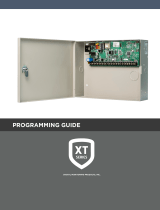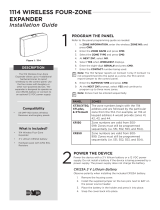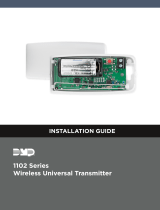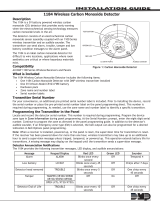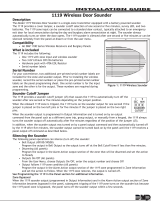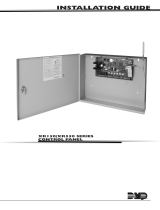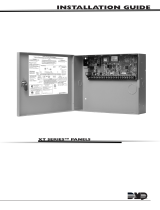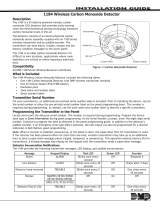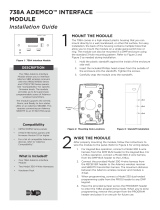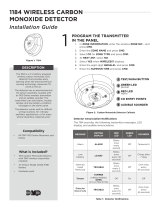Page is loading ...

1119 WIRELESS DOOR SOUNDER
Installation Guide
DESCRIPTION
The Model1119Wireless Door
Sounder is a single‑zone
transmitter equipped with a
battery‑powered sounder that
provides100‑110decibels of
annunciation.
The1119provides a cover tamper,
sounder cuto, survey LED, and two
batteries. Thetransmitter’szone
input can be connected to a
standard door contact, typically
attached to an emergency exit
door for local annunciation during
the day and burglary alarm
annunciation at night. The sounder
always automatically turns on when
the door opens and can be silenced
depending on system configuration.
Compatibility
• All DMP1100Series Wireless
Receivers
• All DMP Burglary Panels
What is Included?
• One1119Wireless Door Sounder
• Two3.0V Lithium CR123A
batteries
• Hardware pack with a470k EOL
resistor and serial number labels
1PROGRAM THE PANEL
To allow the1119sounder to be turned on or silenced by the panel,
the transmitter serial number must be programmed as an output in
OUTPUT INFORMATION and assigned to the ALARM ACTION output
in ZONE INFORMATION. Refer to “Silence the Sounder” for more
information.
Note: When programming both the output and zone, ensure the
Supervision Time is set to the same value.
To enter panel programming, reset the panel and enter 6653 (PROG)
at a keypad. After completing each of the following steps, press CMD
to advance to the next prompt. After you finish programming, go to
STOP and press CMD to save and exit the Programmer menu. For more
information, refer to the appropriate panel programming guide.
PANEL MODEL SLOW RESPONSE FAST RESPONSE
XR Series 450‑474 480‑499
XT Series 31‑34 41‑44
XTL Series 51‑54 61‑64
Table 1: Valid Output Numbers by Panel Model
Program the Output
1. Go to OUTPUT INFO (XR
Series) or OUTPUT SETUP
(XT and XTL Series).
2. At OUTPUT NO, enter the
output number.
Refer to Table 1.
3. At OUTPUT NAME, enter
a descriptive name for the
output.
4. At SERIAL#, enter the
8‑digit device serial number that
starts with 15. Refer to Figure 1.
5. At SUPRVSN TIME, enter the supervision time in minutes.
Program the Zone
1. In ZONE INFORMATION, enter the wireless zone number.
2. At *UNUSED*, enter the zone name.
3. At ZONE TYPE, press any select key or area and select the zone
type.
a. If the sounder should be the only source of annunciation
during a disarmed state, select NT (Night).
b. If the system requires local annunciation at the keypad
when the panel is disarmed, select DY (Day).
4. At AREA NO, select the area where you want the zone assigned.
5. At the NEXT ZONE prompt, select NO.
6. At WIRELESS?, select YES.
7. Enter the eight‑digit SERIAL# that starts with 02. Refer to
Figure 1.
8. At SUPRVSN TIME, enter a supervision time. Default is 240.
9. To allow the panel to control the sounder, select NO at the
NEXT ZONE prompt. The menu advances to ALARM ACTION.
10. At OUTPUT NO, enter the output number that you assigned to
the sounder in the previous section.
Figure 1: Zone and Output
Serial Number Location
ZONE
SN02999999
V112233440
SN15199999
V112233440
OUT
Zone Serial
Number
Output Serial
Number

2 1119 INSTALLATION GUIDE | DIGITAL MONITORING PRODUCTS
MOUNT AND WIRE THE SOUNDER
Mount thesounderon a flat surface or single‑gang switch box away from large metal
objects. See Figure 2for mounting hole locations.
DMP recommends installing zone devices, such as door contacts, within100feet of
thesounder. Use 18or22AWG wire to complete the connections between the1119zone
and the zone device. Terminate the zone with the included470k EOL resistor as shown in
Figure 3.470k EOL
Figure 3: 470k EOL
Resistor
4
5TEST THE SOUNDER
After the devicehas been installed, test to confirm that it is communicating reliably with the panel. Use the Tech
APP™ or Dealer Admin™ to perform a Wireless Check‑in Test on the system. To perform a Wireless Check‑in Test
from a keypad that is connected to the panel, complete the following steps:
At the keypad, enter 8144 (WALK) and select WLS. If the transmitter fails to check in at the keypad, ensure that it is
wired properly and check for sources of interference such as metal objects and electronic equipment.
3The 1119 Wireless Door Sounder provides a Survey LED capability to allow one person to confirm communication with
the wireless receiver or panel while the cover is removed.
1. With the cover removed, hold the device in the desired location.
2. Press the tamper switch to send data to the panel and determine if communication is confirmed or faulty.
Confirmed: If communication is confirmed, for each press or release of the tamper switch, the LED blinks
immediately on and immediately o. Repeat this test to confirm five separate consecutive LED blinks.
Any indication otherwise means proper communication has not been established.
Faulty: If communication is faulty, the LED remains on for about 8 seconds or flashes multiple times in
quick succession. Relocate the device or receiver until the LED confirms clear communication.
SELECT A LOCATION
INSTALL THE BATTERY
2Observe polarity when installing the batteries. Use
only3.0V lithium batteries, such as DMP Model CR123.
Caution: To avoid risk of fire or injury, properly
dispose of used batteries. Do not recharge,
disassemble, incinerate, or heat batteries above212°F
(100°C).
1. Remove the locking screw from the sounder
housing.
2. Lift the cover from the bottom to remove.
3. If replacing the batteries, remove the used batteries
and dispose of them properly. Always replace both
batteries at the same time.
4. Place the two3.0V lithium batteries in the holders
and press into place. See Figure 2 for battery
location.
5. Set the cover back in place and replace the locking
screw.
Figure 2: 1119 PCB
TAMPER
SWITCH
SOUNDER
Zone
Terminals
Sounder
Cuto
Mounting Holes Red Survey LED
Mounting Holes
100/110 dB
Header

1119 INSTALLATION GUIDE | DIGITAL MONITORING PRODUCTS 3
ADDITIONAL INFORMATION
100/110Decibel Jumper
The sounder is equipped with a100/110dB header that changes the decibel output. The default output is110dB. If necessary,
place the jumper over both header pins to enable100dB output. For header locations, refer to Figure 2.
Sounder Cuto Jumper
The1119provides a sounder cuto header that causes thetransmitterto automatically turn o the
sounder after one second or five minutes depending on the jumper position.
When the onboard zone is tripped, thetransmitterturns on the sounder output for one second if
the jumper is placed on the two left pins or for five minutes if the jumper is placed on the two right
pins. Refer to Figure 4. When the sounder output is programmed in OUTPUT INFORMATION and is
turned on by an output command from the panel, thetransmitteralways turns the sounder output o
automatically after five minutes regardless of the position of the jumper.
In addition, when the sounder output was turned on by a panel output command and then automatically turned o by
thetransmitterafter five minutes, the sounder output cannot be turned back on by the panel until thetransmitterreceives a
panel output OFF command.
Silence the Sounder
The following panel operations can silence the sounder:
• BELL OUTPUT (XR150/XR550only)—Program the output in BELL OUTPUT so the sounder turns o at the BELL
CUTOFF time if less than five minutes
• Disarming—Program the output in ALARM ACTION for the zone that will be disarmed, then set the action to STEADY
• OUTPUTS ON/OFF—From the User Menu, select OUTPUTS ON/OFF. Enter the output number and choose OFF
• Output followszone condition—Program the output in ALARM ACTION and set the action to FOLLOW. When
thetransmitterzone restores, the output is turned o
When thesounder output and the ALARM ACTION output become bypassed in the panel, subsequent tripping of
thetransmitterturns on the sounder. However, because the1119panel zone is bypassed, the panel turns the sounder output o
within a few seconds.
Zone Conditions
The1119has been designed primarily for use with the XR150/XR550Series control panels and is capable of sending the
open, normal, or short condition of the zone. In addition, the transmitter sends a tamper signal separately. When used with
XT30/XT50, XTLplus, or XTLtouch Series panels the tamper indication is sent to the panel as an open zone. When programmed
as a Day type zone, a tamper during the day is annunciated at the keypad as an ALERT. When programmed as a Night zone
type, a tamper during the day is annunciated as a Tamper at the keypad.
Battery Life
Typical battery life expectancy for the1119is2 1/2years when programmed as a slow response output where the sounder is
operated for five minutes once a month. Battery life is3months when programmed as fast response output. DMP wireless
equipment uses two‑way communication to extend battery life.
The following conditions also contribute to longer battery life:
• Using a slow response output
• Infrequent transmission trips, such as a door that is rarely used
• Extending transmitter supervision time in panel programming
The following conditions contribute to reduced battery life:
• Using a fast response output
• Multiple sounder on/o operations
• When installed in extreme hot or cold environments
• If a receiver is unplugged or not installed
Note: Transmitters continue to send supervision messages until a receiver returns an acknowledgment. After an
hour the transmitter only attempts a supervision message every60minutes.
1
Sec 5
Min
Figure 4: Sounder Cuto
Jumper

Designed, engineered, and
manufactured in Springfield, MO
using U.S. and global components.
LT-1063 21281
1119 WIRELESS DOOR
SOUNDER
Specifications
Battery
Life Expectancy 2.5 years (slow response)
3months (fast response)
Type 3.0V lithium CR123A
Frequency Range 905 ‑ 924MHz
Dimensions 4.65” L x3.1” W x1.4” H
Color White
Housing Material Flame‑retardant ABS
Compatibility
XR150/XR550
1100X Wireless Receiver Version104or higher
1100XH Wireless Receiver Version105or higher
XT30/XT50
1100D Wireless Receiver Version104or higher
1100DH Wireless Receivers Version105or higher
1100DI Wireless Receivers Version105or higher
Built-In1100Series Receiver
XT50Series Panels Version101or higher
XTLplus Series Panels
XTLtouch Series Panels
Patents
U.S. Patent No. 7,239,236
Certifications
FCC Part15Registration ID CCKPC0123R8
IC Registration ID5251A‑PC0123R8
INTRUSION • FIRE • ACCESS • NETWORKS
2500 North Partnership Boulevard
Springfield, Missouri 65803‑8877
800.641.4282 | DMP.com
FCC INFORMATION
This device complies with Part 15 of the FCC Rules. Operation is subject to the following two conditions:
1. This device may not cause harmful interference, and
2. this device must accept any interference received, including interference that may cause undesired operation.
The antenna used for this transmitter must be installed to provide a separation distance of at least 20 cm (7.874 in.) from all
persons. It must not be located or operated in conjunction with any other antenna or transmitter.
Changes or modifications made by the user and not expressly approved by the party responsible for compliance could void the
user’s authority to operate the equipment.
Note: This equipment has been tested and found to comply with the limits for a Class B digital device, pursuant to part 15
of the FCC Rules. These limits are designed to provide reasonable protection against harmful interference in a residential
installation. This equipment generates, uses and can radiate radio frequency energy and, if not installed and used in
accordance with the instructions, may cause harmful interference to radio communications. However, there is no
guarantee that interference will not occur in a particular installation. If this equipment does cause harmful interference to
radio or television reception, which can be determined by turning the equipment off and on, the user is encouraged to try
to correct the interference by one or more of the following measures:
1. Reorient or relocate the receiving antenna.
2. Increase the separation between the equipment and receiver.
3. Connect the equipment into an outlet on a circuit different from that to which the receiver is connected.
4. Consult the dealer or an experienced radio/TV technician for help.
INDUSTRY CANADA INFORMATION
This device complies with Industry Canada Licence‑exempt RSS standards. Operation is subject to the following two
conditions:
1. This device may not cause interference, and
2. this device must accept any interference, including interference that may cause undesired operation of the device.
This system has been evaluated for RF Exposure per RSS‑102 and is in compliance with the limits specified by Health Canada
Safety Code 6. The system must be installed at a minimum separation distance from the antenna to a general bystander of 7.87
inches (20 cm) to maintain compliance with the General Population limits.
Le présent appareil est conforme aux CNR d’Industrie Canada applicables aux appareils radio exempts de licence. L’exploitation
est autorisée aux deux conditions suivantes:
1. l’appareil ne doit pas produire de brouillage, et
2. l’utilisateur de l’appareil doit accepter tout brouillage radioélectrique subi, même si le brouillage est susceptible d’en
compromettre le fonctionnement.
L’exposition aux radiofréquences de ce système a été évaluée selon la norme RSS-102 et est jugée conforme aux limites établies
par le Code de sécurité 6 de Santé Canada. Le système doit être installé à une distance minimale de 7.87 pouces (20 cm)
séparant l’antenne d’une personne présente en conformité avec les limites permises d’exposition du grand public.
© 2021
/





